Erik Schultheis
SVD-Free Low-Rank Adaptive Gradient Optimization for Large Language Models
May 23, 2025Abstract:Low-rank optimization has emerged as a promising direction in training large language models (LLMs) to reduce the memory usage of adaptive optimizers by constraining learning to a lower-dimensional space. Prior work typically projects gradients of linear layers using approaches based on Singular Value Decomposition (SVD). However, applying SVD-based procedures individually to each layer in large models is computationally expensive and incurs additional memory costs due to storing the projection matrices. In this work, we propose a computationally efficient and conceptually simple two-step procedure to approximate SVD-based gradient projections into lower-dimensional spaces. First, we construct a complete orthogonal basis using predefined orthogonal matrices of the Discrete Cosine Transform (DCT). Second, we adaptively select basis columns based on their alignment with the gradient of each layer. Each projection matrix in our method is obtained via a single matrix multiplication followed by a lightweight sorting step to identify the most relevant basis vectors. Due to the predefined nature of the orthogonal bases, they are computed once at the start of training. During training, we store only the indices of the selected columns, avoiding the need to store full projection matrices for each layer. Our numerical experiments on both pre-training and fine-tuning tasks demonstrate the effectiveness of our dual strategy in approximating optimal low-rank projections, matching the performance of costly SVD-based methods while achieving faster runtime and reduced memory usage.
Labels in Extremes: How Well Calibrated are Extreme Multi-label Classifiers?
Nov 06, 2024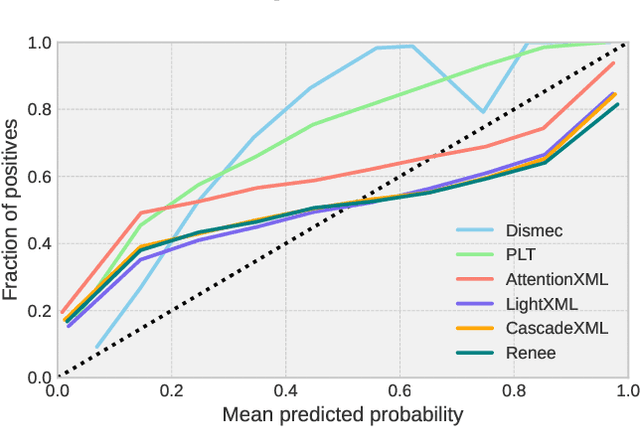


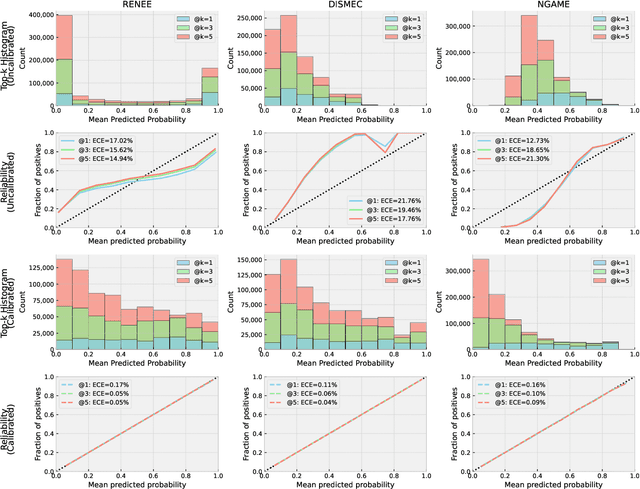
Abstract:Extreme multilabel classification (XMLC) problems occur in settings such as related product recommendation, large-scale document tagging, or ad prediction, and are characterized by a label space that can span millions of possible labels. There are two implicit tasks that the classifier performs: \emph{Evaluating} each potential label for its expected worth, and then \emph{selecting} the best candidates. For the latter task, only the relative order of scores matters, and this is what is captured by the standard evaluation procedure in the XMLC literature. However, in many practical applications, it is important to have a good estimate of the actual probability of a label being relevant, e.g., to decide whether to pay the fee to be allowed to display the corresponding ad. To judge whether an extreme classifier is indeed suited to this task, one can look, for example, to whether it returns \emph{calibrated} probabilities, which has hitherto not been done in this field. Therefore, this paper aims to establish the current status quo of calibration in XMLC by providing a systematic evaluation, comprising nine models from four different model families across seven benchmark datasets. As naive application of Expected Calibration Error (ECE) leads to meaningless results in long-tailed XMC datasets, we instead introduce the notion of \emph{calibration@k} (e.g., ECE@k), which focusses on the top-$k$ probability mass, offering a more appropriate measure for evaluating probability calibration in XMLC scenarios. While we find that different models can exhibit widely varying reliability plots, we also show that post-training calibration via a computationally efficient isotonic regression method enhances model calibration without sacrificing prediction accuracy. Thus, the practitioner can choose the model family based on accuracy considerations, and leave calibration to isotonic regression.
Navigating Extremes: Dynamic Sparsity in Large Output Space
Nov 05, 2024Abstract:In recent years, Dynamic Sparse Training (DST) has emerged as an alternative to post-training pruning for generating efficient models. In principle, DST allows for a more memory efficient training process, as it maintains sparsity throughout the entire training run. However, current DST implementations fail to capitalize on this in practice. Because sparse matrix multiplication is much less efficient than dense matrix multiplication on GPUs, most implementations simulate sparsity by masking weights. In this paper, we leverage recent advances in semi-structured sparse training to apply DST in the domain of classification with large output spaces, where memory-efficiency is paramount. With a label space of possibly millions of candidates, the classification layer alone will consume several gigabytes of memory. Switching from a dense to a fixed fan-in sparse layer updated with sparse evolutionary training (SET); however, severely hampers training convergence, especially at the largest label spaces. We find that poor gradient flow from the sparse classifier to the dense text encoder make it difficult to learn good input representations. By employing an intermediate layer or adding an auxiliary training objective, we recover most of the generalisation performance of the dense model. Overall, we demonstrate the applicability and practical benefits of DST in a challenging domain -- characterized by a highly skewed label distribution that differs substantially from typical DST benchmark datasets -- which enables end-to-end training with millions of labels on commodity hardware.
A General Online Algorithm for Optimizing Complex Performance Metrics
Jun 20, 2024



Abstract:We consider sequential maximization of performance metrics that are general functions of a confusion matrix of a classifier (such as precision, F-measure, or G-mean). Such metrics are, in general, non-decomposable over individual instances, making their optimization very challenging. While they have been extensively studied under different frameworks in the batch setting, their analysis in the online learning regime is very limited, with only a few distinguished exceptions. In this paper, we introduce and analyze a general online algorithm that can be used in a straightforward way with a variety of complex performance metrics in binary, multi-class, and multi-label classification problems. The algorithm's update and prediction rules are appealingly simple and computationally efficient without the need to store any past data. We show the algorithm attains $\mathcal{O}(\frac{\ln n}{n})$ regret for concave and smooth metrics and verify the efficiency of the proposed algorithm in empirical studies.
Learning label-label correlations in Extreme Multi-label Classification via Label Features
May 03, 2024


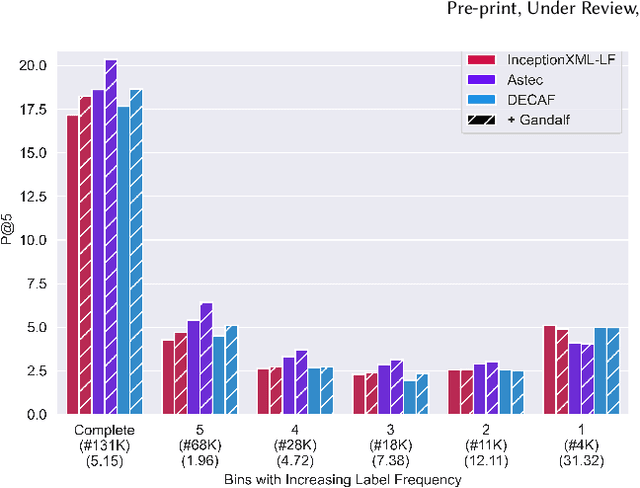
Abstract:Extreme Multi-label Text Classification (XMC) involves learning a classifier that can assign an input with a subset of most relevant labels from millions of label choices. Recent works in this domain have increasingly focused on a symmetric problem setting where both input instances and label features are short-text in nature. Short-text XMC with label features has found numerous applications in areas such as query-to-ad-phrase matching in search ads, title-based product recommendation, prediction of related searches. In this paper, we propose Gandalf, a novel approach which makes use of a label co-occurrence graph to leverage label features as additional data points to supplement the training distribution. By exploiting the characteristics of the short-text XMC problem, it leverages the label features to construct valid training instances, and uses the label graph for generating the corresponding soft-label targets, hence effectively capturing the label-label correlations. Surprisingly, models trained on these new training instances, although being less than half of the original dataset, can outperform models trained on the original dataset, particularly on the PSP@k metric for tail labels. With this insight, we aim to train existing XMC algorithms on both, the original and new training instances, leading to an average 5% relative improvements for 6 state-of-the-art algorithms across 4 benchmark datasets consisting of up to 1.3M labels. Gandalf can be applied in a plug-and-play manner to various methods and thus forwards the state-of-the-art in the domain, without incurring any additional computational overheads.
Consistent algorithms for multi-label classification with macro-at-$k$ metrics
Jan 29, 2024Abstract:We consider the optimization of complex performance metrics in multi-label classification under the population utility framework. We mainly focus on metrics linearly decomposable into a sum of binary classification utilities applied separately to each label with an additional requirement of exactly $k$ labels predicted for each instance. These "macro-at-$k$" metrics possess desired properties for extreme classification problems with long tail labels. Unfortunately, the at-$k$ constraint couples the otherwise independent binary classification tasks, leading to a much more challenging optimization problem than standard macro-averages. We provide a statistical framework to study this problem, prove the existence and the form of the optimal classifier, and propose a statistically consistent and practical learning algorithm based on the Frank-Wolfe method. Interestingly, our main results concern even more general metrics being non-linear functions of label-wise confusion matrices. Empirical results provide evidence for the competitive performance of the proposed approach.
Generalized test utilities for long-tail performance in extreme multi-label classification
Nov 09, 2023Abstract:Extreme multi-label classification (XMLC) is the task of selecting a small subset of relevant labels from a very large set of possible labels. As such, it is characterized by long-tail labels, i.e., most labels have very few positive instances. With standard performance measures such as precision@k, a classifier can ignore tail labels and still report good performance. However, it is often argued that correct predictions in the tail are more interesting or rewarding, but the community has not yet settled on a metric capturing this intuitive concept. The existing propensity-scored metrics fall short on this goal by confounding the problems of long-tail and missing labels. In this paper, we analyze generalized metrics budgeted "at k" as an alternative solution. To tackle the challenging problem of optimizing these metrics, we formulate it in the expected test utility (ETU) framework, which aims at optimizing the expected performance on a fixed test set. We derive optimal prediction rules and construct computationally efficient approximations with provable regret guarantees and robustness against model misspecification. Our algorithm, based on block coordinate ascent, scales effortlessly to XMLC problems and obtains promising results in terms of long-tail performance.
Towards Memory-Efficient Training for Extremely Large Output Spaces -- Learning with 500k Labels on a Single Commodity GPU
Jun 06, 2023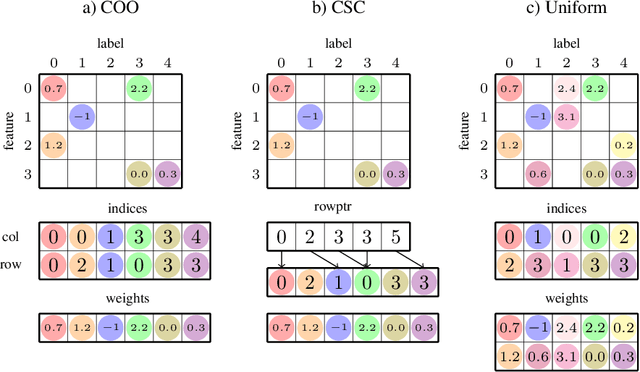
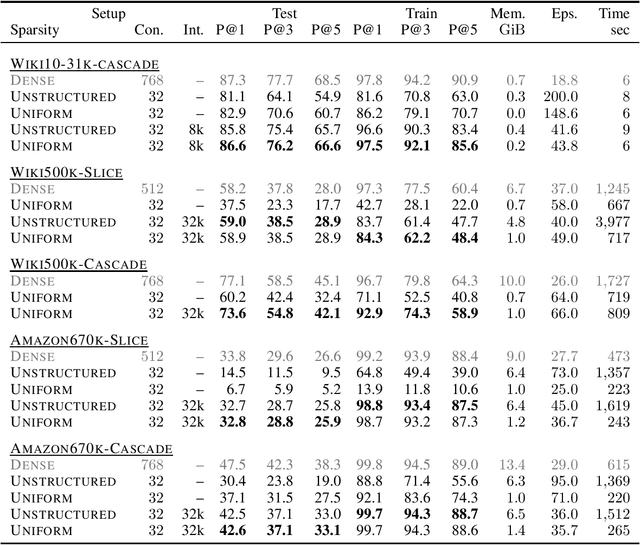
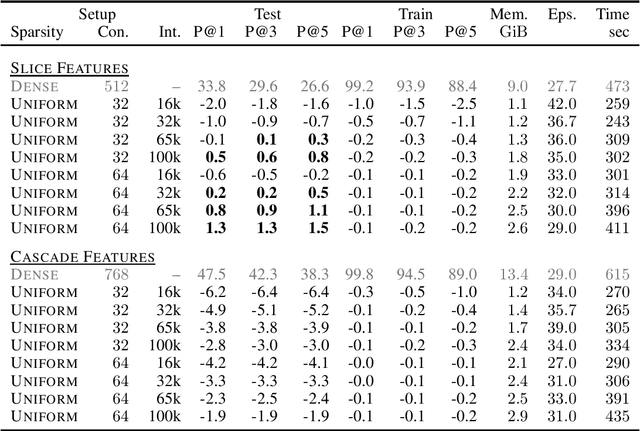
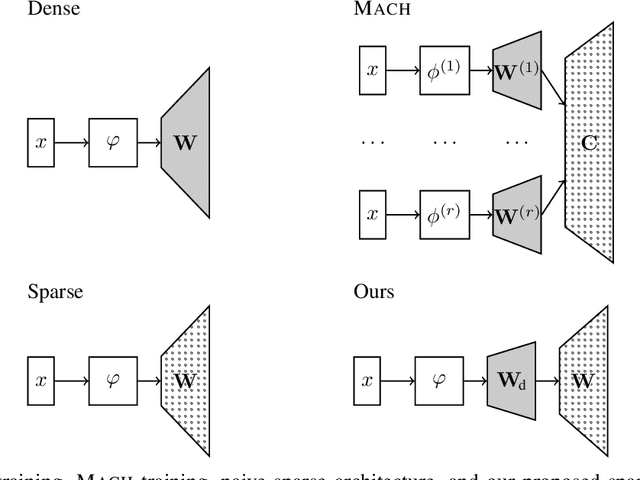
Abstract:In classification problems with large output spaces (up to millions of labels), the last layer can require an enormous amount of memory. Using sparse connectivity would drastically reduce the memory requirements, but as we show below, it can result in much diminished predictive performance of the model. Fortunately, we found that this can be mitigated by introducing a penultimate layer of intermediate size. We further demonstrate that one can constrain the connectivity of the sparse layer to be uniform, in the sense that each output neuron will have the exact same number of incoming connections. This allows for efficient implementations of sparse matrix multiplication and connection redistribution on GPU hardware. Via a custom CUDA implementation, we show that the proposed approach can scale to datasets with 670,000 labels on a single commodity GPU with only 4GB memory.
Physics-guided adversarial networks for artificial digital image correlation data generation
Mar 28, 2023Abstract:Digital image correlation (DIC) has become a valuable tool in the evaluation of mechanical experiments, particularly fatigue crack growth experiments. The evaluation requires accurate information of the crack path and crack tip position, which is difficult to obtain due to inherent noise and artefacts. Machine learning models have been extremely successful in recognizing this relevant information given labelled DIC displacement data. For the training of robust models, which generalize well, big data is needed. However, data is typically scarce in the field of material science and engineering because experiments are expensive and time-consuming. We present a method to generate synthetic DIC displacement data using generative adversarial networks with a physics-guided discriminator. To decide whether data samples are real or fake, this discriminator additionally receives the derived von Mises equivalent strain. We show that this physics-guided approach leads to improved results in terms of visual quality of samples, sliced Wasserstein distance, and geometry score.
CascadeXML: Rethinking Transformers for End-to-end Multi-resolution Training in Extreme Multi-label Classification
Oct 29, 2022Abstract:Extreme Multi-label Text Classification (XMC) involves learning a classifier that can assign an input with a subset of most relevant labels from millions of label choices. Recent approaches, such as XR-Transformer and LightXML, leverage a transformer instance to achieve state-of-the-art performance. However, in this process, these approaches need to make various trade-offs between performance and computational requirements. A major shortcoming, as compared to the Bi-LSTM based AttentionXML, is that they fail to keep separate feature representations for each resolution in a label tree. We thus propose CascadeXML, an end-to-end multi-resolution learning pipeline, which can harness the multi-layered architecture of a transformer model for attending to different label resolutions with separate feature representations. CascadeXML significantly outperforms all existing approaches with non-trivial gains obtained on benchmark datasets consisting of up to three million labels. Code for CascadeXML will be made publicly available at \url{https://github.com/xmc-aalto/cascadexml}.
 Add to Chrome
Add to Chrome Add to Firefox
Add to Firefox Add to Edge
Add to Edge